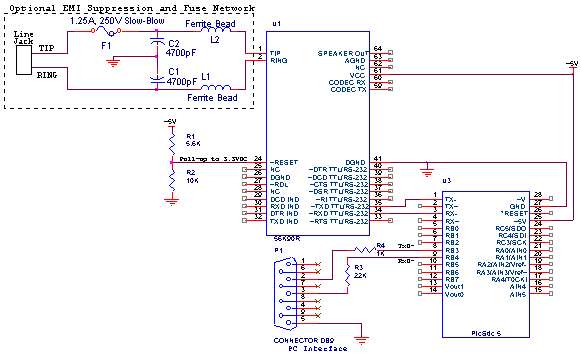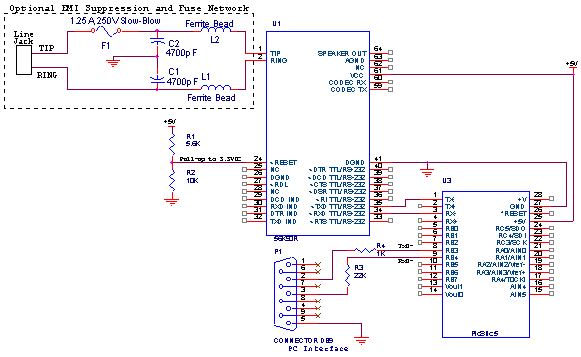
AN208
PicStic 5 & 56K90R
Interfacing the PicStic 5 to Micromint’s 56K90R Modem
January 9, 2002
Introduction: This
application note will demonstrate how to interface Micromint’s PicStic 5
to Micromint’s 56K90R embedded socket modem.
Background:
The PicStic 5 utilizes a pair of RS-485 drivers to allow for a
variety of communication protocols, including RS-232A, RS-485 and RS-422.
This enables the Picstic 5 to communicate with a wide range of devices,
such as PCs and other microcontrollers. With the use of the PicBasic Pro
compiler, the PicStic 5 can also use any of its GPIO as a software serial
port with baud rates up to 2400bps. These software ports can be configured
to send and receive inverted or non-inverted signals. In addition, these
software ports can also be set with modifiers so only specific data
formats are sent or received.
With the help of the 56K90R modem, the
PicStic 5 can now extend its communication capabilities to include
telephone line interfaces. This application note is written under the
pretense that the hardware handshaking of the 56K90R modem has already
been disabled. For a detailed description on disabling the hardware
handshaking of the modem, please refer to Micromint’s 56K90x/2400xEEM
datasheet. For simplicity, the application does not incorporate a speaker
for the modem. If a speaker is desired,
Micromint’s 56K90x/2400xEEM Users Guide can be referenced for
proper connection specifications.
This application can be performed using
two PicStic 5s and two 56K90R modems or by using a PicStic 5, a 56K90R
modem and a standard telephone. Regardless of the method used, either two
separate phone lines or a telephone line simulator will be needed to
conduct this application. The modem uses the standard AT command set.
How it works: This
application note shows how to interface a PicStic 5 to a 56K90R and to a
PC. The program written for the PicStic 5 will provide step-by-step
instructions for using the 56K90R modem. The program will be broken into
two parts, placing a call and receiving a call. The schematic below
illustrates the connections between the modem and the PicStic 5 and the
connections from the PicStic 5 to the PC. Notice the series resistors
between the PicStic 5 and the PC; these are for current limiting to
prevent damage to the PicStic 5, as a software serial port is being used
on two of the PicStic 5’s I/Os. The schematic also shows how to connect
an EMI suppression network between the modem and the telephone line.
Upon powering the PicStic 5 a
menu will appear on the PC allowing the user to place a call or wait to
receive a call. As commands are issued to the modem the PicStic 5 will
give a brief description of the events taking place. Once a connection has
been established a third option will be available. This option will give
the user the ability to terminate the connection. The PicStic 5 will again
give a description of the events as they occur.
When using the PicStic 5 and
56K90R modem to call a standard telephone there will not be a connection
established. Connecting in this configuration will only allow a user to
verify the call by listening to the phone ring. This is not the
recommended configuration for this application, as it does not demonstrate
the full capabilities of the 56K90R modem. If two PicStic 5s and two
56K90R modems are being used then two PCs or a PC with two serial ports
will be needed. In this configuration one PicStic 5 will need to place a
call while the other receives a call. This is the recommended
configuration for this application. To simplify the communications between
the PicStic 5 and the 56K90R modem, the PicStic 5 will configure the modem
to respond in short form.


Program
Listing:
'
'
'
'
'
'
'
'
'
'
'
'
'
'
Controlling the 56K90R modem with the PicStic 5
'
Written in PicBasic Pro Version 2.40
'
January 09, 2002
'
'
'
'
'
'
'
'
'
'
'
'
'
'Definitions
& Variables
DEFINE OSC 8
DEFINE HSER_RCSTA
90H
' Receiver enable for the hardware serial port
DEFINE HSER_TXSTA
20H
' Transmitter enable for the hardware serial port
DEFINE HSER_BAUD
2400
' Baud rate for the hardware serial port
SO
VAR
PORTB.3
' Software Transmit pin
SI
VAR PORTB.4
' Software Receive pin
BAUD
CON
16468
' Software Baud rate
ADCON1 = 7
STRINPUT
VAR BYTE
' Input variable
STRARRAY
VAR BYTE[7]
' Input variable array
TELENUM
VAR BYTE[11]' Telephone number to
be called
NUMSIZE
VAR BYTE
' Number of digits in the phone number
HIGH PORTC.1
PAUSE 1
'
' Menu
'
MENU:
SEROUT2
SO,BAUD,["Please select from the options listed
below",10,13,10,13]
SEROUT2 SO,BAUD,["1.
Place outgoing call",10,13]
SEROUT2 SO,BAUD,["2.
Wait for incoming call",10,13]
CHKVAL:
SERIN2 SI,BAUD,[
DEC1 STRINPUT ]
SELECT CASE
STRINPUT
CASE 1
GOTO MKCALL
CASE 2
GOTO RVCALL
CASE ELSE
SEROUT2 SO,BAUD,[ "Please select 1 or 2",10,13,10,13]
GOTO CHKVAL
END SELECT
'
'MAKE A CALL
'
MKCALL:
GOSUB INITALZ
'
' Get number to
dial
'
GTNUM:
SEROUT2
SO,BAUD,["Is the number to be dialed a long distance number
(y/n)?",10,13,10,13]
SERIN2
SI,BAUD,[STRINPUT]
SELECT CASE
STRINPUT
CASE 78
GOTO TENDIGIT
CASE 89
GOSUB AREACODE
CASE ELSE
GOTO GTNUM
END SELECT
'
' Build the
telephone number (11-digit)
'
TELENUM[0]=49
FOR STRINPUT = 0
TO 2
TELENUM[STRINPUT+1]
= STRARRAY[STRINPUT]
NEXT STRINPUT
GOSUB LOCAL
FOR STRINPUT = 0
TO 6
TELENUM[STRINPUT+4]
= STRARRAY[STRINPUT]
NEXT STRINPUT
NUMSIZE = 10
GOTO DIAL
TENDIGIT:
SEROUT2
SO,BAUD,["Does the number need to be in 10-digit format(y/n)?",10,13,10,13]
SERIN2
SI,BAUD,[STRINPUT]
SELECT CASE
STRINPUT
CASE 78
GOTO SVNDIGIT
CASE 89
GOSUB AREACODE
CASE ELSE
GOTO GTNUM
END SELECT
'
' Build the
telephone number (10-digit)
'
FOR STRINPUT = 0
TO 2
TELENUM[STRINPUT]
= STRARRAY[STRINPUT]
NEXT STRINPUT
GOSUB LOCAL
FOR STRINPUT = 0
TO 6
TELENUM[STRINPUT+3]
= STRARRAY[STRINPUT]
NEXT STRINPUT
NUMSIZE = 9
GOTO DIAL
'
' Build the
telephone number (7-digit)
'
SVNDIGIT:
GOSUB LOCAL
FOR STRINPUT = 0
TO 6
TELENUM[STRINPUT]
= STRARRAY[STRINPUT]
NEXT STRINPUT
NUMSIZE = 6
GOTO DIAL
AREACODE:
SEROUT2
SO,BAUD,["Enter the 3-digit area code",10,13,10,13]
SERIN2
SI,BAUD,[STR STRARRAY\3]
RETURN
LOCAL:
SEROUT2
SO,BAUD,["Enter the 7-digit telephone number",10,13,10,13]
SERIN2
SI,BAUD,[STR STRARRAY\7]
RETURN
DIAL:
SEROUT2
SO,BAUD,["Is the number below the correct number and in the correct
format to dial (y/n)?"]
SEROUT2 SO,BAUD,[10,13,10,13]
FOR STRINPUT = 0
TO NUMSIZE
SEROUT2 SO,BAUD,[
TELENUM[STRINPUT] ]
NEXT STRINPUT
SEROUT2 SO,BAUD,["
",10,13,10,13]
SERIN2
SI,BAUD,[STRINPUT]
SELECT CASE
STRINPUT
CASE 78
GOTO GTNUM
CASE 89
GOTO SEND
CASE ELSE
GOTO DIAL
END SELECT
SEND:
SEROUT2
SO,BAUD,["The PicStic 5 will dial the number that was provided using
the following AT SEROUT2 SO,BAUD,[“Command",10,13]
SEROUT2
SO,BAUD,["ATD + the number provided",10,13,10,13]
'
' Send the
command to the modem and receive acknowledgement
'
HSEROUT ["ATD"]
FOR STRINPUT = 0
TO NUMSIZE
HSEROUT [TELENUM[STRINPUT]
]
NEXT STRINPUT
HSERIN [DEC
STRINPUT]
SELECT CASE
STRINPUT
CASE 3
GOSUB NOCARR
GOTO GTNUM
CASE 4
GOSUB ERR
GOTO GTNUM
CASE 6
GOSUB NODIALT
GOTO GTNUM
CASE 7
GOSUB BUSY
GOTO GTNUM
CASE 8
GOSUB NOANSW
GOTO GTNUM
END SELECT
SEROUT2
SO,BAUD,["A connection was established. Now try to receive a
call.",10,13]
GOSUB FIN
GOTO MENU
RVCALL:
'
' Connect the
modem
'
GOSUB INITALZ
'
' Set modem to
answer after 3 rings
'
THREERING:
SEROUT2
SO,BAUD,["The PicStic 5 will now set the modem to answer after 3
rings",10,13]
SEROUT2
SO,BAUD,["This is done by sending the following AT
Command",10,13,10,13]
SEROUT2 SO,BAUD,["ATS0=3",10,13,10,13]
'
' Send the
command to the modem and receive acknowledgement
'
HSEROUT
["ATS0=3",10,13]
HSERIN [ STRINPUT]
IF STRINPUT<>48
THEN
SEROUT2 SO,BAUD,["An error has occurred, press
ENTER",10,13,10,13]
SERIN2 SI,BAUD,[ STRINPUT ]
GOTO THREERING
ENDIF
'
' Wait for
incoming call
'
INCOMING:
SEROUT2
SO,BAUD,["When called, the modem will transmit '2'(short-form for
RING) to the ",10,13]
SEROUT2
SO,BAUD,["controller 3 times before answering. After the modems
answers, there ",10,13]
SEROUT2
SO,BAUD,["will be a 10 to 20 sec delay while a connection is
established.",10,13,10,13]
SEROUT2
SO,BAUD,["Dial the modem now.",10,13]
NUMSIZE = 0
'Set counter to zero
RWAIT:
HSERIN [STRINPUT]
SELECT CASE
STRINPUT
CASE 50
GOTO RINGCNT
CASE 51
GOSUB NOCARR
GOTO INCOMING
CASE 52
GOSUB ERR
GOTO INCOMING
CASE ELSE
GOTO RWAIT
END SELECT
RINGCNT:
NUMSIZE = NUMSIZE
+ 1
IF NUMSIZE = 3
THEN
SEROUT2 SO,BAUD,[" ",10,13]
GOTO RECCALL
ELSE
SEROUT2 SO,BAUD,["Ring number " , NUMSIZE , "has
occurred",10,13]
GOTO RWAIT
ENDIF
RECCALL:
SEROUT2
SO,BAUD,["A connection was established. Now try to make a
call.",10,13]
GOSUB FIN
GOTO MENU
'
'
' SHARED ROUTINES
'
'
FIN:
SEROUT2
SO,BAUD,["The escape command will be sent to break the
connection.",10,13]
SEROUT2
SO,BAUD,["Then the hang-up command will be issued.",10,13]
SEROUT2
SO,BAUD,["By default the escape command is '+++'.",10,13]
SEROUT2
SO,BAUD,["The hang-up command is ATH",10,13,10,13]
HSEROUT
["+++",10,13]
HSERIN [
STRARRAY[0] ]
HSEROUT ["ATH",10,13]
HSERIN [
STRARRAY[1] ]
SEROUT2
SO,BAUD,["Press any key to continue"]
SERIN2
SI,BAUD,[STRINPUT]
FOR STRINPUT =0
TO 40
SEROUT2 SO,BAUD,["
",10,13]
NEXT STRINPUT
RETURN
INITALZ:
'
' Connect the
modem
'
SEROUT2
SO,BAUD,["Make sure all connections to the modem are
correct",10,13]
SEROUT2
SO,BAUD,["Apply power to modem then press ENTER",10,13,10,13]
SERIN2 SI,BAUD,[
STRINPUT ]
'
' ECHO OFF
'
RETRY:
SEROUT2
SO,BAUD,["The PicStic 5 will now disable the ECHO on the
modem",10,13]
SEROUT2
SO,BAUD,["This is done by sending the following AT
Command",10,13,10,13]
SEROUT2 SO,BAUD,["ATE0",10,13,10,13]
'
' Send the
command to the modem and receive acknowledgement
'
HSEROUT
["ATE0",10,13]
HSERIN [STR
STRARRAY\2]
IF
(STRARRAY[0]<>111) OR (STRARRAY[1]<>107) THEN
SEROUT2 SO,BAUD,["Verify that the connections to the modem are
correct and press ENTER",10,13,10,13]
SERIN2 SI,BAUD,[ STRINPUT ]
GOTO RETRY
ENDIF
'
' Enable
short-form
'
SHRTFRM:
SEROUT2
SO,BAUD,["The PicStic 5 will now enable short-form response on the
modem",10,13]
SEROUT2
SO,BAUD,["This is done by sending the following AT
Command",10,13,10,13]
SEROUT2 SO,BAUD,["ATV0",10,13,10,13]
'
' Send the
command to the modem and receive acknowledgement
'
HSEROUT
["ATV0",10,13]
HSERIN [ STRINPUT]
IF STRINPUT<>48
THEN
SEROUT2 SO,BAUD,["An error has occurred, press
ENTER",10,13,10,13]
SERIN2 SI,BAUD,[ STRINPUT ]
GOTO SHRTFRM
ENDIF
RETURN
NOCARR:
SEROUT2
SO,BAUD,["A NO CARRIER error has been generated. Verify connections
and retry.",10,13]
SEROUT2
SO,BAUD,["Press any key to continue",10,13,10,13]
SERIN2
SI,BAUD,[STRINPUT]
RETURN
ERR:
SEROUT2
SO,BAUD,["An ERROR has been generated. Verify connections and
retry.",10,13]
SEROUT2
SO,BAUD,["Press any key to continue",10,13,10,13]
SERIN2
SI,BAUD,[STRINPUT]
RETURN
NODIALT:
SEROUT2
SO,BAUD,["A NO DIAL TONE error has been generated. Verify connections
and retry.",10,13]
SEROUT2
SO,BAUD,["Press any key to continue",10,13,10,13]
SERIN2
SI,BAUD,[STRINPUT]
RETURN
BUSY:
SEROUT2
SO,BAUD,["The number dialed is busy wait 10 seconds and
retry.",10,13]
SEROUT2
SO,BAUD,["Press any key to continue",10,13,10,13]
SERIN2
SI,BAUD,[STRINPUT]
FOR STRINPUT = 10
TO 1 STEP -1
SEROUT2
SO,BAUD,[STRINPUT]
PAUSE 990
SEROUT2 SO,BAUD,["
",8,8]
NEXT STRINPUT
RETURN
NOANSW:
SEROUT2
SO,BAUD,["There was no answer at the number dialed. Lets try
again.",10,13]
SEROUT2
SO,BAUD,["Press any key to continue",10,13,10,13]
SERIN2
SI,BAUD,[STRINPUT]
RETURN
END